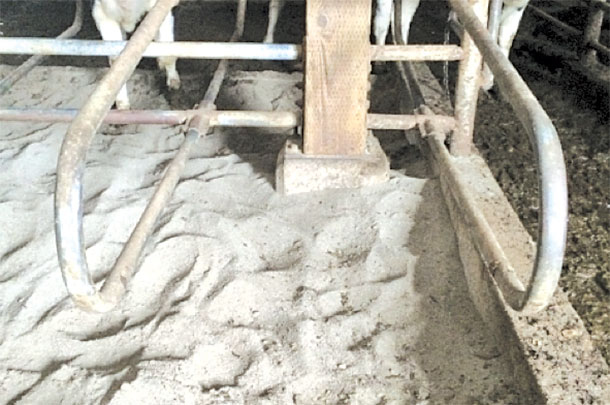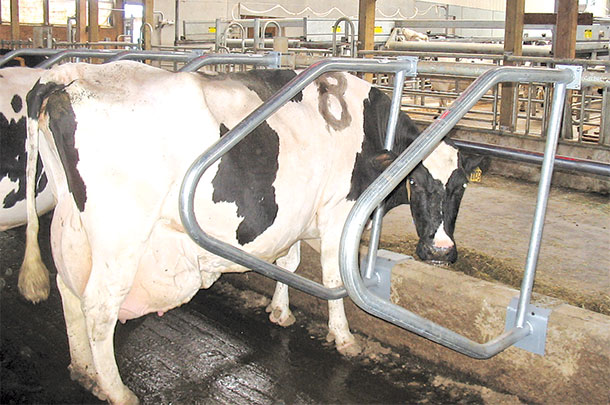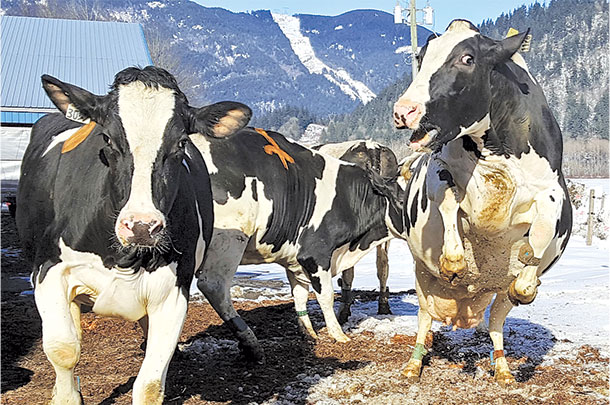Providing a comfortable environment for the animals under our care is fundamental to what it means to be a good dairy farmer and is something we take pride in as an industry. This is one reason why cow comfort features prominently in dairy industry standards, including the Farmers Assuring Responsible Management (FARM) Program.
Producers should provide at least one lying stall for each cow and should have at least 2 feet of bunk space per cow – and 2.5 feet per cow for pregnant cows.
Giving cows the right space
Cows require more than just any space; they require space that meets their needs. For example, the FARM Program specifies “all age classes of cattle have a resting area that provides cushion, insulation, warmth, dryness and traction at all times when away from the milking facility” and that “concrete, rubber mats, water beds and mattresses can only be acceptable resting surfaces when they are adequately bedded; the lack of adequate bedding reduces lying time and increases the risk of lameness and injuries.”
One way to identify problems in stall design is to look for behaviors such as lying in the alley, dog-sitting and perching with just the front hooves on the stall surface. Also look for problems as the cow lies down and stands up.
For example, do you see (or hear) the cow coming into contact with the stall hardware, including the stall partitions and neck rail, or do you see cows having problems as they lunge forward to stand up?
A practical way to avoid these problems is to measure each stall to determine whether the right space is available. For example, are stalls at least 4 feet wide and 10 feet in length to allow for adequate lunge space? Are stall partitions bent out of place such that some stalls are too narrow?
Is there anything to obstruct the lunge space, including fencing, excess bedding, etc.? Is the stall surface well maintained with copious amounts of clean, dry bedding?
If the cow can feel or see anything on the lying surface other than bedding, then the stall is unsuitable for use. Mattresses, rubber mats or any other surface with little or no bedding put comfort at risk, as do stall structures that restrict free standing and lying movements.
Poorly designed or maintained spaces can result in “hidden” overstocking, even if stocking rates appear adequate on paper (Photo 1).
Space for the vulnerable cow
It is also important to consider the animals in your barn have different needs. For example, some animals are socially subordinate, meaning they face heightened risks in competitive environments. Younger, first-lactation cows are often among these more subordinate animals, as are animals that are lame or sick.
This variation among animals helps to explain why some cows can still do well within poor facilities. For example, it is well-known overstocking at the freestall reduces stall usage (especially lying times), but it is important to realize the more vulnerable cows, including transition cows and lame cows, are mostly likely to be affected. For these cows, consider using an understocked pen.
Space at the feeder
A barn can be appropriately stocked in terms of one resource important to cows (e.g., lying stalls) but seriously overstocked in terms of other resources (e.g., feeder and drinker space). Our data shows barns are often overstocked in terms of feeding space; many farms offer less than even the 2 feet required for all cattle, and few farms provide the 2.5 feet recommended for pregnant cattle.
A series of studies have shown competition for feed increases rapidly as stocking density increases. Reduced feeder access results in reduced feeding times and more time standing inactive in the feed alley as cows wait to feed (Photo 2).

One reason for overstocking at the feeder is flawed barn design. Pen layout should start with the constraint of how much space is required for all cows to feed comfortably. At 2.5 feet per cow, a 100-cow pen requires at least 250 feet from which the cows can access feed delivered in the feed alley.
If cows are also provided stalls that are the standard 4 feet in width, then two rows of 50 freestalls each will require just 200 feet, leaving plenty of space for wide crossover alleys or even wider stalls. This layout results in a “two-row” (or “four-row” if built as a mirror image) barn, as two rows of stalls access a single feed alley.
These barns are long (in this example, 250 feet) and narrow (say, 42 feet to allow room for lots of lunge space in the stalls and wide alleys).
Unfortunately, all too often these design constraints are reversed. The designer instead calculates the maximum number of lying stalls that can fit into a given space, favoring barns with a square-shaped layout. The same floor area as I described in the previous example could be configured as a 200-feet-long and 52 feet-wide pen, with 130 stalls in three rows (hence the extra width).
But this configuration leaves each cow only 1.5 feet of feeding space, much less than the cow requires. To avoid overstocking at the feedbunk, start your barn planning by making sure each cow will have lots of feeding space and, as a rule of thumb, avoid three-row (and six-row) layouts.
Conclusion
My key message is simple: Avoid overstocking. Your commitment to your cows is to provide the space they need to access important resources.
When measuring the stocking rates in your barn, do this separately for each resource your cows require. Sometimes a pen can be appropriately stocked in terms of one type of space (e.g., stalls for lying) but be overstocked in terms of another (e.g., space at the feeder).
Also consider the quality of the space. For example, in many barns at least some stalls are not suitable for cows (e.g., because of poor maintenance or errors in stall design); these stalls should not be included in your calculation of stocking rates.
There is a large body of scientific evidence showing the problems for cows associated with overstocking at both the lying stall and the feed alley. Overstocking increases competition for these resources and reduces the cow’s ability to lie down and to feed, especially at key times of the day when the cow is most highly motivated to engage in these activities.
Overstocking is especially harmful for the most vulnerable animals in our herd, including the sick and lame animals that are socially subordinate.

New work is now required on providing space outdoors to relieve stocking pressure inside the barn; this approach might be especially important at times when the barn would otherwise be overstocked (Photo 3). ![]()
PHOTO 1: This photo shows one stall in our barn – the space cows need to lunge forward when lying down and standing up is fully blocked by the supporting pillars for the roof. Any stalls that are poorly designed or maintained (e.g., broken or bent stall dividers) should not be included in your stocking density calculations.
PHOTO 2: Cows are subjected to competition at the feedbunk, especially when overstocked, but some feedbunk designs reduce this competition. Cows are most affected by overstocking at the feeder when feeding in more open systems. Head-locking feed barriers provide some protection from this competition, but the highest level of protection is provided by well-spaced side barriers as illustrated in this photo. Courtesy photos.
PHOTO 3: Ongoing work at UBC is investigating the effects of different types of outdoor access on dairy cows; this work shows that cows are highly motivated to access pasture, as well as other types of outdoor area such as the pack shown here. Providing space outdoors can also relieve stocking pressure inside the barn and might be especially important at times when the barn would otherwise be overstocked. Photo by Jennifer Van Os, UBC.
Daniel Weary is a Professor and NSERC Industrial Research Chair with the University of British Columbia. Email Daniel Weary.






